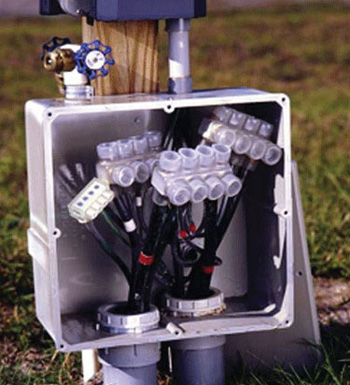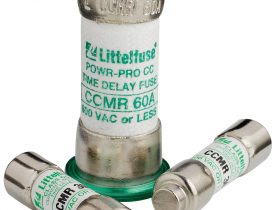When deciding what type of connector material works best in an electrical application, specifiers and inspectors alike may instinctively assume copper is the best choice. And indeed, it may be. But there are some applications for which aluminum poses a cost-effective, easier and longer lasting alternative. In order to ensure that electrical connections are proper, safe, and in accordance with electric code, it is important to first understand not only when it may be best for specifiers to select an aluminum connector, but also what specific traits to look for in each connector as well as a connector supplier. From there, it becomes much easier to test and approve the installed connection.

Photo 1. Compression connectors (Courtesy of FCI-Burndy Products)
Some material history
Copper has earned its solid reputation in the electrical connector industry, having proven particularly useful in residential installations. It should come as no surprise that performance levels with copper is high, as copper is, in fact, one of the oldest known metals. First used in about 8700 BC in what is now Iraq, and extremely popular in Ancient Egypt, copper owned 100 percent of the metals market for about 5000 years until the arrival of gold. Copper has had innumerable uses during this period, from early utensils, to ornaments and weapons, through the Bronze Age when it was alloyed with arsenic and tin.
All this being said, copper may be an omnipresent element, but it is far from the only choice for electrical connectors — a good thing considering its escalating cost in recent years. Aluminum is actually a better fit for some customers who have more industrial or commercial applications.
Aluminum is relatively young in age compared to copper. In 1787 Antoine Lavoisier identified bauxite as the oxide of a still undiscovered metal, and in 1825 Hans Christian Oersted has been credited with preparing the first metallic aluminum from bauxite, which is a claylike rock found in the earth. With its high electrical conductivity, ductility and low atomic mass, aluminum is frequently used in everything from electric transmission lines to the coating on telescope mirrors to aluminum foils used in food preparation and storage.
Aluminum is also being specified more frequently in recent years as a great option for electrical connectors, including mechanical and compression terminals, splices and taps. In industrial and commercial installations, such as substations and utility distribution and transmission lines, aluminum connectors are particularly well-suited for these applications due to their lightweight composition, high conductivity, and ease of installation.
Mechanical vs. compression
If you find the specifier has selected aluminum for the installation, the next step is to ensure that not only have the proper aluminum connectors been selected, but that the most competent and knowledgeable connector supplier possible is involved in the process. Knowing that a renowned connector supplier is associated with an installation should give you the confidence that a job is being installed correctly and in accordance with codes. It is important to note though that aluminum terminals, splices and taps are offered in both mechanical and compression types, and there are advantages to each. Because there are no codes dictating which method to use, it is important to be aware of the merits of each in order to properly assess a quality connection.
Mechanical connectors are easy to install, requiring no special installation tooling. Though mechanical connectors may be individually more expensive than compression connectors, the capital investment incurred with the purchase of installation tooling for the compression process is substantial. Aluminum mechanical connectors are also reusable, have the flexibility to accommodate a wide range of cable, run cooler than conductors being joined, and have high mechanical strength.
Compression connectors do have their advantages however, and are typically the chosen method with larger organizations responsible for bigger installations. Compression installations are made to last — they are irreversible and offer an extremely high holding strength. Aluminum compression connectors deliver high quality connections at a low installed cost after the initial investment in special tooling has been made.
Determining whether to go with mechanical or compression connectors is usually an installation-driven decision for specifiers, with cost a fairly consistent underlying factor. After this decision has been made, there are still other variables to consider.
Choosing the right aluminum products
Whether you encounter aluminum mechanical or compression connectors, you should be careful to guarantee that the specifier selected a manufacturer that offers features such as:
- Dual-rated products for use on both aluminum and copper conductors.
- Connector sections that are heavy enough to carry full electrical loads of conductors and withstand the forces applied during installation.
- Contact surfaces that are finished and protected to prevent reformation of non-conducting oxides.
- Contact paths that are as short and direct as possible
- Connector designs that prevent moisture and corrosive media penetration into contact areas from causing potential corrosion.
- Ensure that pressure applied from bolts as well as from compression tools is well-distributed over the contact surface and does not weaken the conductor.
- Electro-tin plated contact surfaces that provide for durable, long-lasting, corrosion-resistant connections, if required.
Also, a sound electrical equipment manufacturer produces a wide enough range of aluminum products with the right materials and properties to meet exactly your application needs. For example, for bolted mechanical connectors, look for heat-treatable alloys that deliver the right combination of conductivity and strength. For compression connectors, you will want to make sure that a high-conductivity, malleable grade aluminum that supplies the right level of ductility is being implemented.
All aluminum connectors should have required hardware that is both high strength and provides resistance to corrosion and galling. Some companies go so far as to offer hardware that is coated with a lubricant that not only prevents galling, but also results in optimum performance for recommended installation torques.
Oxide film is an environmental byproduct of aluminum that, if not properly addressed, can be problematic. The effects of oxide film, which is present on all aluminum surfaces and can cause high contact resistance, can be best combated by employing a connector that incorporates a material designed to inhibit oxide and minimize galvanic corrosion. By ensuring that such a connector is implemented, you can help ward off detrimental corrosion during the service life of the connection.

Photo 2. Mechanical connectors (Courtesy of FCI Bundy)
Of course, all compression connectors should conform to applicable sections of the National Electric Code, and all products used are required to meet the UL 486A–486B Standard and potentially even have CSA 22.2 No. 65 certification. Again, there are manufacturers who offer products that meet all of these standards, enabling you to have good faith in the quality of the product and concentrate solely on the quality of the installation.
Proper installation is essential
Obviously, selecting the appropriate aluminum connector for the conductor and application is only the first step in ensuring a successful aluminum-based connection. After you have verified that an appropriate connector is being implemented, you need to make sure the specifier has:
- Measured and marked the recommended insulation strip length, then carefully cut and removed the insulation to avoid nicking strands
- Wire brushed the stripped length of wire and un-plated aluminum contact pad thoroughly to remove surface oxides
- Applied an oxide inhibiting compound to any exposed conductor surface before inserting the conductor into the connector
- For compression connectors, selected the appropriate installation tool and die — then completed the process with the required number of crimps
- For mechanical connectors, torque all hardware to recommended values according to hardware material and size
Conclusion
Aluminum connectors are by no means right for every application. There are certainly many installations, including those on the residential side, where copper is the material that makes the most sense. But in order to ensure that specifiers are selecting connections that work best for a given application and budget, you should consider all the feasible options, including the connector material and connection type, before making sure that the proper installation guidelines have been adhered to. By connecting with the right information up front, you’re much more likely to encounter successful connections on the job.










Find Us on Socials